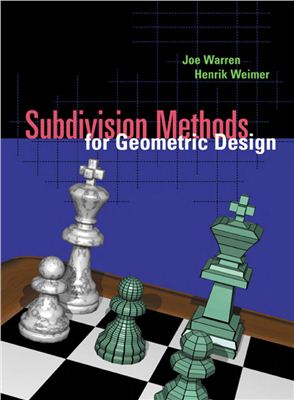Издательство Morgan Kaufmann, 2002, -316 pp.
Considerable effort has been expended over the last forty years in the area of geometric design, the goal of which is to develop efficient and flexible representations of complex shapes. Applications of geometric design are broad and varied; they include aerospace and automotive design, industrial design, and computer animation for interactive games, commercials, and full-length feature films.
B?zier curves, developed independently by Pierre Bґezier at Renault and Paul de Casteljau at Citroen in the early ’60s, were one of the first successful computer representations. They are still the representation of choice in some applications. Bґezier curves were followed by B-splines, which were introduced into geometric design in the mid ’70s by Riesenfeld and others. B-splines possess a beautiful underlying theory that leads to a wide range of highly efficient algorithms, which is why they have become the standard representation in geometric design systems. B-spline surfaces do however have a severe shortcoming. They can only represent a limited set of surface topologies—namely, topological disks, cylinders, and tori.
The search for a representation that overcomes the topological limitations of B-splines began shortly after the introduction of B-splines to geometric design. Inspired by George Chaikin’s work that described curves as the limit of a sequence of subdivision steps, two teams of researchers (Ed Catmull and Jim Clark, and Malcolm Sabin and D. Doo) independently developed the notion of subdivision surfaces in 1978.
Subdivision surfaces naturally admit arbitrary surface topologies. They were initially met with considerable enthusiasm, but since they lacked the beautiful and powerful theory of B-splines, they were treated as a rather exotic representation for nearly 20 years. That began to change in the mid ’90s. Advances were made on a number of fronts by researchers in numerous disciplines, including approximation theory, numerical analysis, and computer graphics. These surfaces are rapidly establishing themselves as the new representation of choice, and I predict that in coming years they will largely supplant B-splines in many application domains. In feature film production here at Pixar for instance, subdivision surfaces are already the preferred way to represent the shape of virtually everything that moves.
The authors of this book have been on the forefront of these advances, and this book represents the first comprehensive description of subdivision methods. However, the book is not simply a collection of material that can be found in the open literature. Rather, it offers a deep and unique perspective into the world of subdivision. I leaed a tremendous amount from reading this book. I’m sure you will too.
Subdivision: Functions as Fractals
An Integral Approach to Uniform Subdivision
Convergence Analysis for Uniform Subdivision Schemes
A Differential Approach to Uniform Subdivision
Local Approximation of Global Differential Schemes
Variational Schemes for Bounded Domains
Averaging Schemes for Polyhedral Meshes
Spectral Analysis at an Extraordinary Vertex
Considerable effort has been expended over the last forty years in the area of geometric design, the goal of which is to develop efficient and flexible representations of complex shapes. Applications of geometric design are broad and varied; they include aerospace and automotive design, industrial design, and computer animation for interactive games, commercials, and full-length feature films.
B?zier curves, developed independently by Pierre Bґezier at Renault and Paul de Casteljau at Citroen in the early ’60s, were one of the first successful computer representations. They are still the representation of choice in some applications. Bґezier curves were followed by B-splines, which were introduced into geometric design in the mid ’70s by Riesenfeld and others. B-splines possess a beautiful underlying theory that leads to a wide range of highly efficient algorithms, which is why they have become the standard representation in geometric design systems. B-spline surfaces do however have a severe shortcoming. They can only represent a limited set of surface topologies—namely, topological disks, cylinders, and tori.
The search for a representation that overcomes the topological limitations of B-splines began shortly after the introduction of B-splines to geometric design. Inspired by George Chaikin’s work that described curves as the limit of a sequence of subdivision steps, two teams of researchers (Ed Catmull and Jim Clark, and Malcolm Sabin and D. Doo) independently developed the notion of subdivision surfaces in 1978.
Subdivision surfaces naturally admit arbitrary surface topologies. They were initially met with considerable enthusiasm, but since they lacked the beautiful and powerful theory of B-splines, they were treated as a rather exotic representation for nearly 20 years. That began to change in the mid ’90s. Advances were made on a number of fronts by researchers in numerous disciplines, including approximation theory, numerical analysis, and computer graphics. These surfaces are rapidly establishing themselves as the new representation of choice, and I predict that in coming years they will largely supplant B-splines in many application domains. In feature film production here at Pixar for instance, subdivision surfaces are already the preferred way to represent the shape of virtually everything that moves.
The authors of this book have been on the forefront of these advances, and this book represents the first comprehensive description of subdivision methods. However, the book is not simply a collection of material that can be found in the open literature. Rather, it offers a deep and unique perspective into the world of subdivision. I leaed a tremendous amount from reading this book. I’m sure you will too.
Subdivision: Functions as Fractals
An Integral Approach to Uniform Subdivision
Convergence Analysis for Uniform Subdivision Schemes
A Differential Approach to Uniform Subdivision
Local Approximation of Global Differential Schemes
Variational Schemes for Bounded Domains
Averaging Schemes for Polyhedral Meshes
Spectral Analysis at an Extraordinary Vertex

